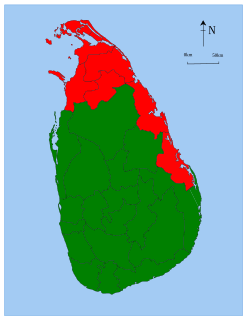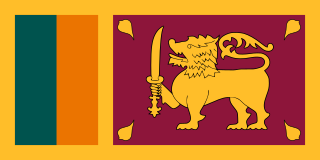 W
WThe 1982 Sri Lankan national referendum took place on December 22, 1982, giving the people of Sri Lanka the option to extend the life of parliament by 6 years. It was the first and so far only national referendum to be held in Sri Lanka. The referendum was called for by President J. R. Jayawardene, who had been elected to a fresh six-year term as President in October 1982. With the life of the current parliament due to expire in August 1983, Jayawardene faced the possibility of his ruling United National Party losing its massive supermajority in parliament if regular general elections were held. He therefore proposed a referendum to extend the life of parliament, with its constituents unchanged, thereby permitting the United National Party to maintain its two-thirds parliamentary majority.
 W
WThe 1987–1989 JVP insurrection was the second unsuccessful armed revolt which was conducted by the Janatha Vimukthi Peramuna against the Government of Sri Lanka under President J. R. Jayewardene. Unlike the first unsuccessful JVP insurrection of 1971, the second insurrection was not an open revolt, instead, it appeared to be a low intensity conflict that lasted from 1987 to 1989 with the JVP resorting to subversion, assassinations, raids and attacks on military and civilian targets with the government undertaking counter-insurgency operations to suppress the JVP.
 W
W1989 Temple of the Tooth attack is an attack on the Temple of the Tooth Relic, located in Kandy, Sri Lanka. The shrine, which is considered to be important to the Buddhists in Sri Lanka, houses the relic of the tooth of the Buddha, and is a UNESCO designated World Heritage Site. It was attacked on 8 February 1989, allegedly by the armed cadres affiliated to Janatha Vimukthi Peramuna (JVP), a Marxist-Leninist Communist political party in Sri Lanka.
 W
WThe 2004 Sri Lanka tsunami-rail disaster is the largest single rail disaster in world history by death toll, with probably 1,700 fatalities or more. It occurred when a crowded passenger train was destroyed on a coastal railway in Sri Lanka by a tsunami which followed the 2004 Indian Ocean earthquake. The tsunami subsequently caused over 30,000 reported deaths and billions of rupees in property damage in the coastal areas of Sri Lanka.
 W
WBlack July is the common name used to refer to the anti-Tamil pogrom and riots in Sri Lanka during July 1983. The riots began as a response to a deadly ambush on 23 July 1983, which caused the death of 13 Sri Lanka Army soldiers, by the Tamil militant group Liberation Tigers of Tamil Eelam (LTTE).
 W
WThe 1958 anti-Tamil pogrom and riots in Ceylon, also known as the 58 riots, refer to the first island wide ethnic riots and pogrom to target the minority Tamils in the Dominion of Ceylon after it became an independent dominion from Britain in 1948. The riots lasted from 22 May until 29 May 1958 although sporadic disturbances happened even after the declaration of emergency on 27 May 1958. The estimates of the murders range, based on recovered body count, from 158 to 1,500. Although most of the victims were Tamils, majority Sinhalese civilians and their property was also affected both by attacks by Tamil mobs throughout the Batticaloa and Jaffna districts as well as Sinhalese mobs who attacked those Sinhalese who provided sanctuary to Tamils. As the first full-scale race riot in the country in over forty years, the events of 1958 shattered the trust the communities had in one another and led to further polarisation.
 W
WThe 1956 anti-Tamil pogrom, also known as the Gal Oya riots, was the first organised pogrom against Sri Lankan Tamils in the Dominion of Ceylon. The worst of the violence took place in the Gal Oya valley, where local majority Sinhalese colonists and employees of the Gal Oya Development Board commandeered government vehicles, dynamite and weapons and massacred minority Tamils. It is estimated that over 150 people lost their lives during the violence. Although initially inactive, the police and army were eventually able to bring the situation under control.
 W
WBetween 1948 and 1972, Ceylon was an independent country in the Commonwealth of Nations that shared a monarch with Australia, Canada, New Zealand, the United Kingdom, and certain other sovereign states. In 1948, the British Colony of Ceylon was granted independence as Ceylon. In 1972, the country became a republic within the Commonwealth, and its name was changed to Sri Lanka.
 W
WEelam War II is the name given to the second phase of armed conflict between Sri Lankan military and the separatist Liberation Tigers of Tamil Eelam. The war started after the failure of peace talks between the Premadasa government and the LTTE. This phase of the war was initiated by the LTTE who massacred almost 600 Sinhalese and Muslim police personnel after they were ordered by the Premadasa government to surrender to the LTTE. The truce was broken on June 10, 1990 when the LTTE in October expelled all the 28,000 Muslims residing in Jaffna.
 W
WSri Lanka was one of the countries struck by the tsunami resulting from the Indian Ocean earthquake on December 26, 2004. On January 3, 2005, Sri Lankan authorities reported 30,000+ confirmed deaths.
 W
WThe history of Sri Lanka from 1948 to present is marked by the independence of the country through to Dominion and becoming a Republic.
 W
WIndia–Sri Lanka maritime boundary agreements were signed in 1974 and 1976 between India and Sri Lanka to define the international maritime boundary between the two countries. Treaties on maritime boundary were necessary to facilitate law enforcement and resource management, and to avoid conflict, in the waters since both countries located closely in the Indian ocean, particularly in Palk Strait.
 W
WThe burning of the Jaffna Public Library took place on the night of June 1, 1981, when an organized mob of Sinhalese individuals went on a rampage, burning the library. It was one of the most violent examples of ethnic biblioclasm of the 20th century. At the time of its destruction, the library was one of the biggest in Asia, containing over 97,000 books and manuscripts.
 W
WThe Nehru-Kotelawala Pact was an agreement that was signed between Jawaharlal Nehru, the Prime Minister of India, and John Kotelawala, the Prime Minister of Sri Lanka, on 18 January 1954. It was an agreement in regarding to the status and future of people of Indian origin in Ceylon. They were brought by British from Madras Presidency in British India to work in tea, coffee and coconut plantations of British Ceylon.
 W
WThe Sirima–Gandhi Pact or Srimavo-Gandhi Pact was an agreement that was signed between Sirimavo Bandaranaike, the Prime Minister of Sri Lanka, and Indira Gandhi, the Prime Minister of India, on 28 June 1974. It was a follow-up agreement of Sirima-Shastri Pact that left 150,000 people of Indian origin in Sri Lanka to future account. Sirima-Shastri Pact agreed to grant Ceylonese citizenship to 300,000 Indian population in Sri Lanka and 525,000 people repatriation to India.
 W
WThe Sirima–Shastri Pact or Srimavo-Shastri Pact was an agreement that was signed between Sirimavo Bandaranaike, the Prime Minister of Sri Lanka, and Lal Bahadur Shastri, the Prime Minister of India, on 30 October 1964. Officially, it was known as Agreement on Persons of Indian Origin in Ceylon. It was a significant agreement in determining the status and future of people of Indian origin in Ceylon.
 W
WThe 1977 anti-Tamil pogrom in Sri Lanka followed the 1977 general elections in Sri Lanka where the Sri Lankan Tamil nationalistic Tamil United Liberation Front won a plurality of minority Sri Lankan Tamil votes in which it stood for secession. Around 300 Tamils were killed in the riots.